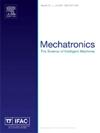具有刚性车轮的滑转向行星漫游者的倾斜滑车的优点
IF 3.1
3区 计算机科学
Q2 AUTOMATION & CONTROL SYSTEMS
引用次数: 0
摘要
世界各地的月球探测活动正在推动低质量滑轨月球车的发展,对于这种月球车来说,带有滑轨的刚性车轮很常见。在这项工作中,与v偏置型格纹相比,具有倾斜格纹的车轮(即从车轮表面的内缘到外缘以一定角度跨越,而不是直接跨越)在滑向转向点性能方面具有优势,而不会降低爬坡性能。在GRC-1月球模拟器上进行了单轮试验,车轮沿滑转向点转向对应的代表性滑移角定向。倾斜滑车获得正切线转弯力FT,这是一种度量,用于确定车轮能够维持滑向点转弯的条件。与v偏置高达0.6的滑移比相比,倾斜式滑车在滑移比低于0.4的情况下获得了正FT,同时也只经历了大约一半的下沉。另一方面,在直线行驶中,与标称行驶和爬坡有关的性能几乎没有差异。用4个适当配置的倾斜滑轮进行的全漫游车测试验证了点转弯和爬坡性能,爬坡时平均滑向转向点转弯滑移比约为0.35和0.8。本文章由计算机程序翻译,如有差异,请以英文原文为准。
Advantages of slanted grousers for skid-steer planetary rovers with rigid wheels
Lunar exploration activities around the world are driving development of low mass skid-steer rovers, for which rigid wheels with grousers are common. Wheels with slanted grousers (i.e. that span from the inner to the outer edge of the wheel surface at an angle, rather than directly across) are compared favorably in this work against V-offset shaped grousers in skid-steer point turn performance, without any reduction in slope climbing performance. Single wheel tests are conducted in GRC-1 lunar simulant with the wheels oriented along a representative slip angle corresponding to skid-steer point turning. Slanted grousers achieve positive tangent turning force, , a metric introduced to identify conditions when a wheel can sustain skid-steer point turning. The slanted grouser achieves a positive at slip ratios below 0.4 compared to as much as 0.6 for V-offset, while also only experiencing approximately half as much sinkage. On the other hand, there is little to no difference in performance in straight line driving, relevant for nominal driving and slope climbing. Full rover tests with 4 appropriately configured slanted grouser wheels validate point turn and slope climbing performance with an average skid-steer point turn slip ratio of approximately 0.35 and 0.8 for slope climbing.
求助全文
通过发布文献求助,成功后即可免费获取论文全文。
去求助
来源期刊

Mechatronics
工程技术-工程:电子与电气
CiteScore
5.90
自引率
9.10%
发文量
0
审稿时长
109 days
期刊介绍:
Mechatronics is the synergistic combination of precision mechanical engineering, electronic control and systems thinking in the design of products and manufacturing processes. It relates to the design of systems, devices and products aimed at achieving an optimal balance between basic mechanical structure and its overall control. The purpose of this journal is to provide rapid publication of topical papers featuring practical developments in mechatronics. It will cover a wide range of application areas including consumer product design, instrumentation, manufacturing methods, computer integration and process and device control, and will attract a readership from across the industrial and academic research spectrum. Particular importance will be attached to aspects of innovation in mechatronics design philosophy which illustrate the benefits obtainable by an a priori integration of functionality with embedded microprocessor control. A major item will be the design of machines, devices and systems possessing a degree of computer based intelligence. The journal seeks to publish research progress in this field with an emphasis on the applied rather than the theoretical. It will also serve the dual role of bringing greater recognition to this important area of engineering.
 求助内容:
求助内容: 应助结果提醒方式:
应助结果提醒方式:


